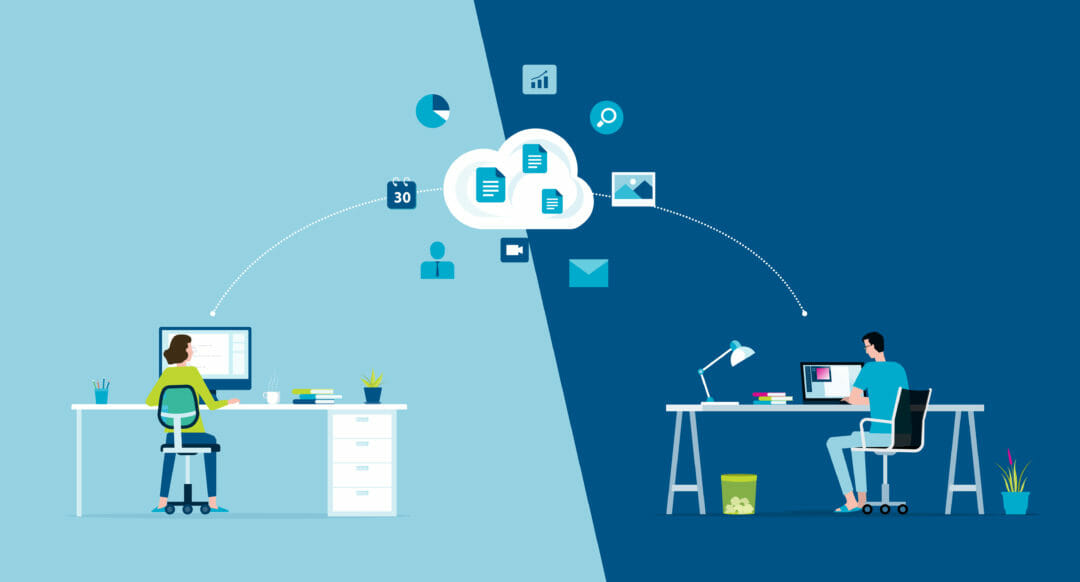In just 12 months, the phrase “new normal” peaked. Remote working isn’t new anymore, it’s just normal. It’s the daily reality for millions of workers worldwide. Recent research from the EU showed the numbers of people working from home across Europe increased from 5% in 2019 to almost 40% by Spring 2020. In the UK specifically, the latest figures from the ONS (published July 2020) show that almost half (46.6%) of the entire population had done some work from home because of the pandemic.
It has been a significant change for everyone, not least for IT departments who had to cope with the initial scramble to get employees online at home, as well as the ongoing battle to keep their organisations functioning and secure. We’re also now facing a seismic shift in the future of work. Huge multinationals like Unilever announced that staff are never going back to the office full-time, and research from Gartner finds that 80% of company leaders plan to permit remote work after pandemic.
So, what have we learned about remote working in the year since global lockdowns began? And given that remote working is here to stay, what can we learn about how to do it “right”? It’s time for remote working’s performance review. Here are three key lessons from the past year.
1. Making working from anywhere seamless.
Hybrid working (splitting time between the office and home) is the most likely future model for many organisations. The key to getting this right is enabling genuine flexibility. Rather than worrying about how many employees want to work in the office for a set number of days a week, organisations should focus on simply being flexible. Hybrid working is about arming staff with the tools to move freely between locations, whenever they choose. This means investing in technologies to make the switch between locations seamless. And tech has to be free of niggles. It needs to “just work”.
Unified Communications (UC) is one solution. Whether an employee is working in an office, their bedroom, or a coffee shop (post-pandemic), the experience must be consistent and hassle-free, or productivity will plummet. This means seamlessly switching from voice and video calling, and being able to access calling, chat, and virtual meeting spaces in a single collaboration platform, regardless of what device is used. Solutions like Microsoft Teams have seen usage skyrocket, and we expect that trend to continue as more organisations adopt hybrid working. Seamless UC-enabled working benefits the business through enhanced employee productivity and efficiency, which has a positive impact on the bottom line.
An accelerated tech strategy and a hybrid working future — CANCOM CTO
2. Security more essential than ever.
Securing millions of newly remote workers almost overnight was a huge undertaking. Against the need to keep businesses and essential services running (including public sector bodies like councils), security may not have been the primary considerations. Most organisations have now spent time going back to “plug the gaps”, but there’s no doubt that a proliferation of devices and the increased use of cloud services has left companies more vulnerable. McAfee found a 630% increase in attacks on cloud infrastructure since the start of the pandemic, and in just one month between March and April 2020, IBM recorded a 6,000% increase in phishing attempts.
As well as ensuring remote/flexible working policies are up to date, there are a host of tactics companies can employ to address security. This includes mobile device management and endpoint security, strict patch management and complete backing up of the Microsoft 365 environment, which many assume is done automatically by Microsoft, but isn’t, which can result in a catastrophic loss of data.
Another security approach is to focus on identity and access management (IAM) to enable single sign-on and smart identity management. Centering security around users’ identities not only provides the best level of protection but it supports the previous point by reducing barriers for employees accessing the corporate network. It enables both frictionless and secure connection, regardless of location or device.
How to handle the long-term impact of Covid-19 on cloud security
3. Human element should take priority.
The final and most important lesson is that employee wellbeing should come first. Half of UK workers (51%) reported feeling ‘burnt out’ at the end of 2020, with the blurring of boundaries between work and home being a contributing factor. Employers must address this or run the risk overburdening staff and affecting their health. Home working is, at its core, a great idea. Many of us have embraced the flexibility and the lack of a daily commute. But when other elements are considered – from caring for dependents to not having a dedicated home office space – pressure can quickly mount.
When remote, it is easy to schedule back-to-back calls and flit between tasks with no break. In fact, many employees are working longer. A World Economic Forum study found employees home working during Covid-19 lockdowns have seen the “…length of their working days increase, been sending more emails, and attending more meetings…”. Organisations must put in place controls that avoid overworking — even considering limits on when corporate networks and email servers are active. Training and enablement for managers on how to identify and address burnout will be essential. This should include adoption and change management protocols that ensure the shift to home and hybrid working does not endanger staff wellbeing.
As we approach the end of a year of lockdowns, we’re all still on a steep learning curve. But these three lessons outlined above should be key takeaways for any organisation exploring hybrid and remote working. Even as vaccines offer hope of a return to more regular ways of life, the nature of work has changed irreversibly. As post-pandemic remote working becomes just “working”, it’s time to make changes to support employees now.








